Table of Contents
Poison Ivy 101: How To Identify And Treat Poison Ivy
Originally this post was supposed to include how to rid your yard of poison Ivy, too, but it just got too long….So check out part 2 – Poison Ivy Removal – 10 Best Ways To Get Rid Of Poison Ivy Plants.
Disclaimer: I am not a medical doctor and nothing in this article should be taken as medical advice. Please talk to your doctor before using any of the herbs and/or remedies mentioned in this article.
This post may contain affiliate links. Please read my disclosure if you have questions.
Thank you for supporting this site with purchases made through links in this post.
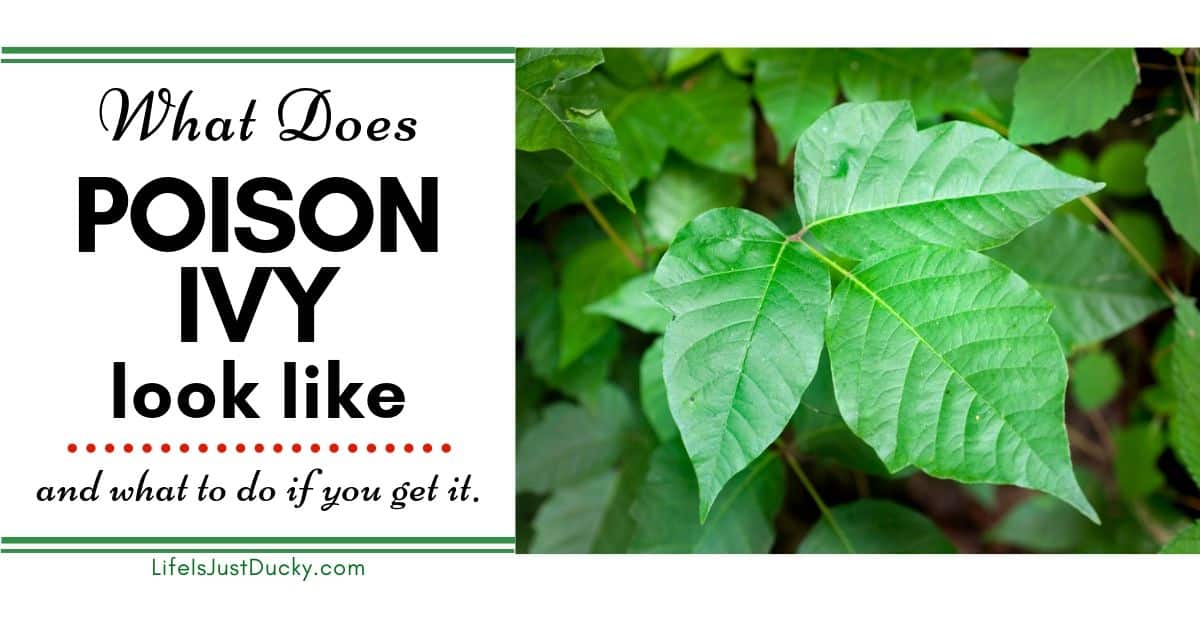
How to identify poison ivy and ways to help prevent getting a rash if you come in contact with it.
I was a kid who liked to roam around in the woods, climb trees, pick berries clad only in a T-shirt and shorts, usually barefoot.
When I got married I discovered how most of the world lives…afraid of poison ivy.
All my husband had to do was “think he saw some way off in the distance” and the blisters would break out.
Fast forward to the approaching of my daughter’s wedding. She had gotten a new homestead. A beautiful 2 acres in the country with ancient old oaks. We dubbed it “Twisted Oaks” after a tree that had wrapped around another one.
We were cleaning out brush and weeds tidying it up so we could have her reception on the grounds when I found it.
More than a little patch of poison ivy.
It climbed the trees, ran across the lawn popping up everywhere. I jokingly changed the name to “Ivy Acres”. Donned some gloves and long sleeves “just in case”, after all, I wasn’t allergic and set to work pulling all that poison ivy out.
The next day was a whole new adventure for me. Where my sleeves and gloves pulled apart and left a gap, started appearing big red blisters. Itchy painful blisters. Over the next few days, they just kept growing.
My reign as “Miss Immune To Poison Ivy” was over. I now had a lot to learn about that dreaded plant. I set out to learn how to identify and treat poison ivy. And how to keep from getting it again.
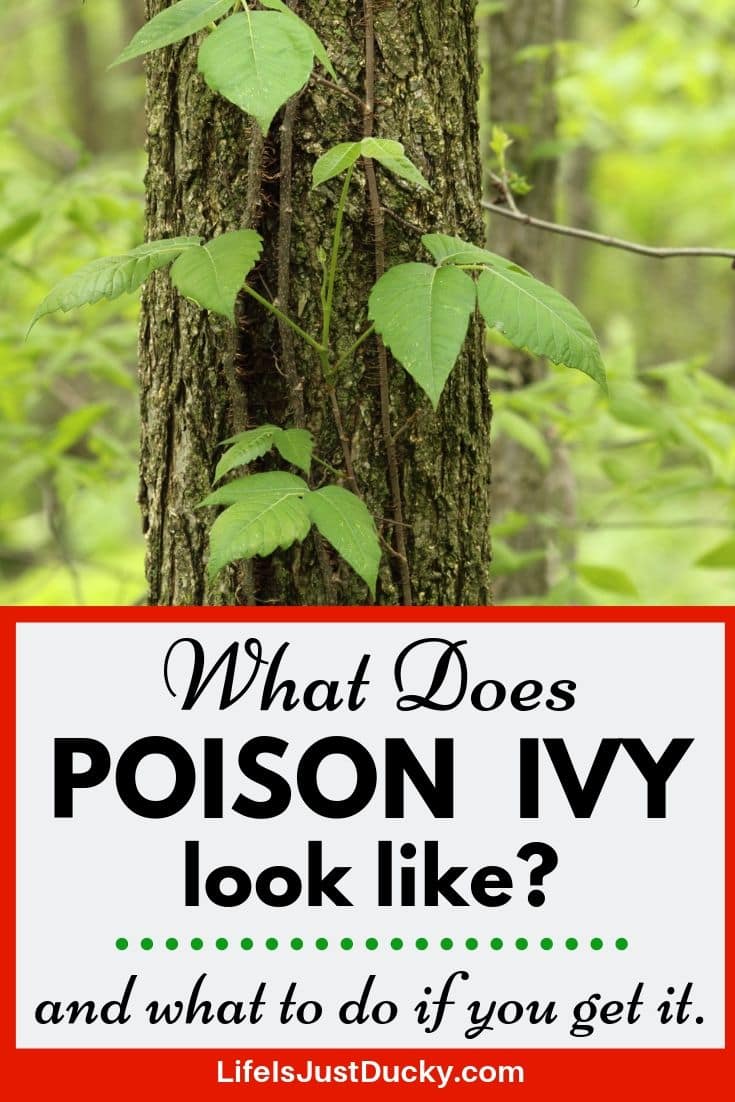
Most People Are Allergic To Poison Ivy
It is estimated that almost 85% of people have some type of allergic reaction to poison ivy. Some people have mild reactions and others are so sensitive that they will catch it without even touching it. Reactions can be severe and some can even be life-threatening.
But the kicker is, even if you are in that 15% of non-allergic. The more you are exposed, the more likely you will develop a sensitivity to it, like I did.
Humans are one of the few animals who are allergic to poison ivy. Goats eat it, deer eat it, and birds eat the seeds, all to no ill effects. Dogs seldom get a rash, probably because their fur protects them. But if you touch their exposed fur, you can get it from them.
Related: 12 Ways To Make Weeds – Go Away!
So how do you keep from suffering from that nasty rash?
First….
Learn to recognize the poison ivy plant.
The best way to keep from getting the rash and blisters is to know what it looks like.
This is tougher than you might think.
Poison ivy, Toxicodendron radicans, is an interesting plant in that it takes many forms. But, understanding its many forms is helpful.
Yes, poison ivy has clusters of three leaves. But in some parts of the country, and at different stages of maturity, the leaves can be smooth or have ridges along the edge. Some even look like mittens.
The color of the leaves varies from season to season, reddish in spring or new growth, green in the summer, and orange or red in the fall.
They can be either shiny or dull, usually, the new growth is shiny and gets duller as it ages.
The veins that run across the leaf are non-symmetrical (not directly across from each other). The leaves have pointed ends, not rounded.
[Tweet “How to identify and treat poison ivy. #poisonivy #homesteading #weeds”]
Poison Ivy Is Everywhere!
In spring the plant may have tiny buds or flowers, which become white or grayish berries later in the season. When the vine is mature, it will appear like a hairy rope growing up a tree.
Poison Ivy is found all over the continental United States except in the desert. Often found in dappled sunlight, but also lurks in shady spots.
It can vine up a tree or pole, climbs walls, twine along a fence, grow into a shrub, and even grow underground for many feet to find another tree to grow up.
The vine grows rampant where it is left undisturbed and can fill an area making it difficult to walk through and even harder to kill.
It’s helpful to know the old sayings.
These are just a few, I’m sure, but they can make it easy to remember and teach to your children.
Leaves of three, let them be.
Berries of white, run in fright.
Red leaflets in the spring, it’s a dangerous thing.
Hairy vine, no friend of mine.
Leaves of three, I hate thee.
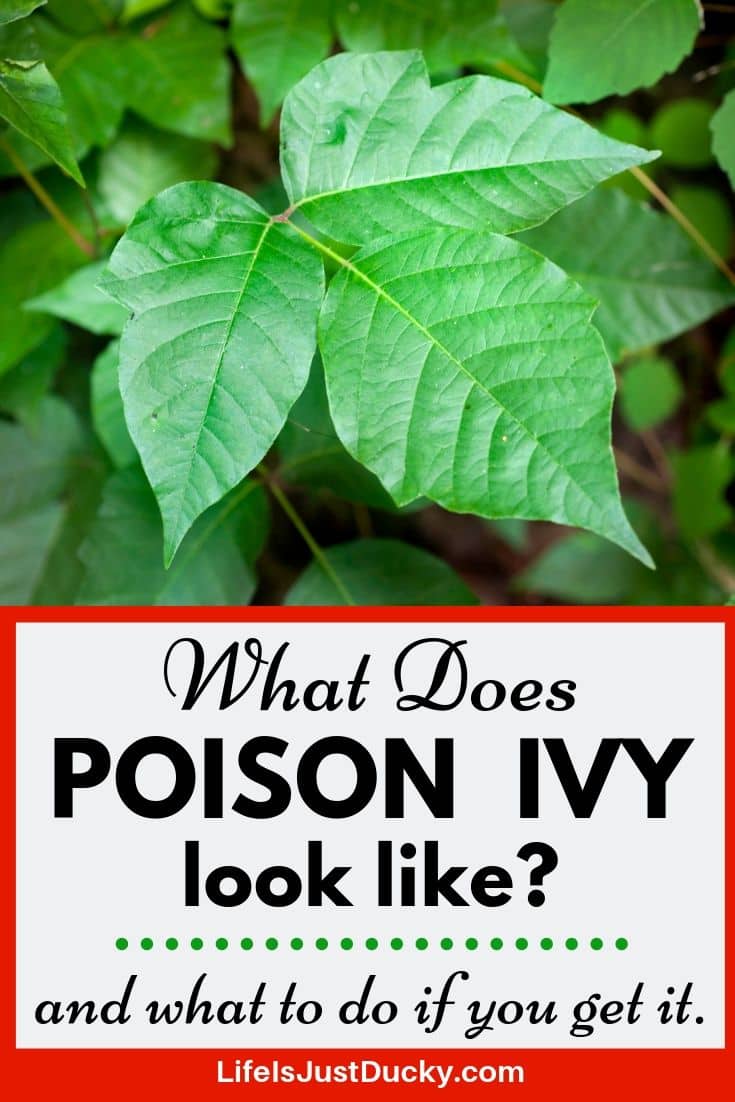
Here are a few things to help you identify the dreaded poison ivy.
-
A vine with groups of three pointy leaves
-
The middle leaf has a slightly longer petiole (stem) than the two leaves on the side
-
The leaflets are larger at the base
-
There are no thorns on the stem
-
Berries, if present, are a grey-ish white
-
Leaves are green during summer, red during spring and fall
-
It can grow just about anywhere!
It has three distinct forms:
-
a hairy vine that climbs trees
-
ground cover up to 1–2 feet
-
large shrub
Make sure your kids know exactly what these plants look like too, so they don’t show up with it in a beautiful bouquet of wildflowers for mom.
Why Is Poison Ivy So Bad? What Is Urushiol?
The effects after you brush up against this most irksome plant are the same: a terrible, itchy, blistery rash, caused by the presence of urushiol, the oily resin that the plant produces.
Not only is poison ivy very, may I repeat, very hard to kill, (It is one of the most tenacious plants out there.) It is also laden with an oily resin called urushiol. Urushiol is the bad stuff that you are allergic to. This oil is on ALL Parts of the poison ivy plant. The leaves, stems, roots, berries. In other words, no part of the plant is safe to touch. It can even get into the soil around the plant and roots.
How Do You Get A Poison Ivy Rash? How To Identify And Treat Poison Ivy.
From first touching the oil of the plant, it takes about 10 to 15 minutes for the oil’s molecules to bind with protein in the epidermal cells. If the skin area is callused – say the soles of your feet and palms – it takes longer, or it might fail to bond.
Once the oil bonds with protein in the skin, the damage is done. (So the quicker you get it off you the better)
Poison ivy is really not “poisonous”. It’s your body’s allergic response that is the problem.
Exposure can cause a form of contact dermatitis. The resulting rash can range from mild to severe, depending on how much urushiol gets on your skin and your own sensitivity to it.
Is Everyone Allergic To Poison Ivy?
Believe it or not, most of us are born into this world immune to poison ivy. But that can change at any time, even well into adulthood. When that happens, it almost always means that the allergy lasts for the rest of your life.
Symptoms can occur within two hours or less after contact or take up to three days to appear and then it can last – for – weeks.
The rash can be caused by direct contact with urushiol by touching the plants or by indirect contact with the plant oil that may have contaminated a pet’s fur, tools, clothing, or other surfaces.
Airborne contact is also possible if these plants are broken in any way. Such as being pulled up, being cut by a lawnmower or a weed whacker, being rototilled, or especially if it is burned. It can affect the lungs as well if the urushiol is inhaled.
NEVER BURN POISON IVY.
Just touching it can transfer this oil to your body, clothing, tools, or your dog or cat’s fur. And – It – Never – Goes – Away. Not unless it’s washed off anyway. Even dead plants are infectious.
Seriously, urushiol has still been found active on surfaces decades later and is believed to still be active indefinitely if not washed off.
Besides your sensitivity to it, the severity of the rash depends on the amount of urushiol that gets on your skin. A section of skin with more urushiol on it may develop a rash sooner and the rash may appear more severe. In some instances, new lesions may continue to appear for up to two to three weeks.
Related: To Till Or Not To Till – That Is The (Gardening) Question.
Just remember, urushiol is very concentrated stuff. A tiny (and I mean tiny) amount can cause a full-blown reaction.
However, the fluid from a blister does not spread the rash. Scratching it does not spread the rash. (as long as there is no urushiol still under your fingernails.) So you can’t pass the rash to someone else from your rash. You can, however, pass it on from the oils that may still be on your clothes, shoes, gloves, tools….
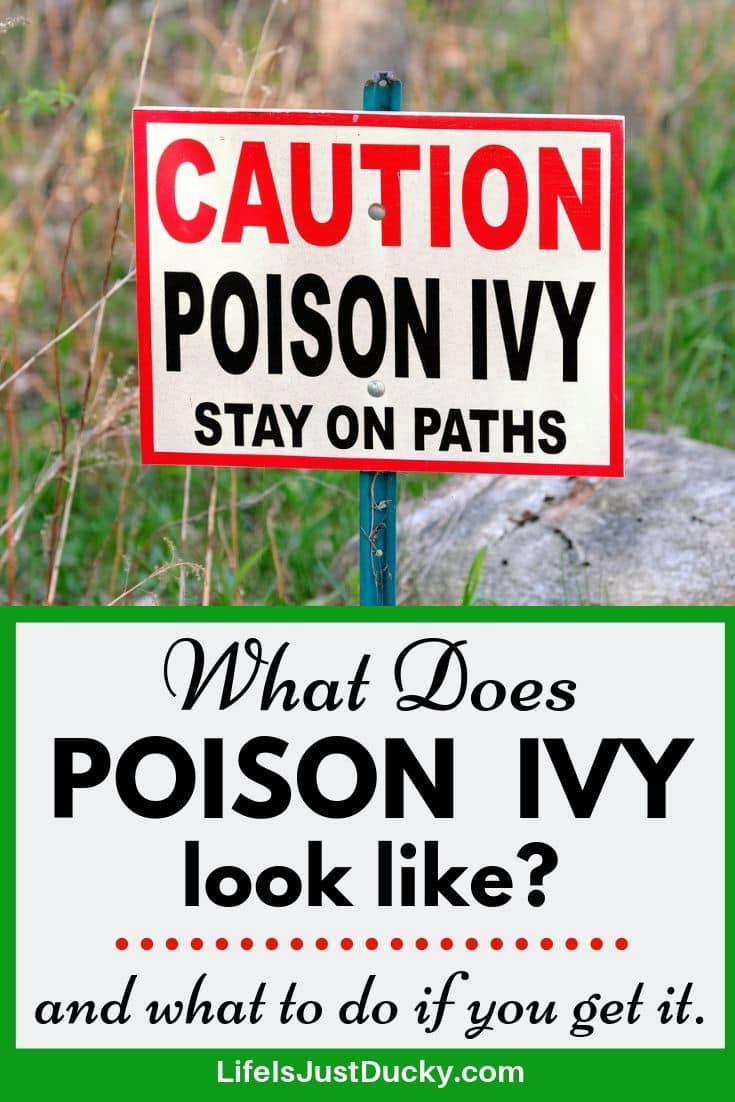
The signs and symptoms can include the following:
-
Redness of the skin
-
Swelling
-
Itching
-
An outbreak of small or large blisters
-
In rare cases, an anaphylactic reaction can occur
Related: How To Grow An Herb Garden – And Why You Should.
What to do if you think you have touched poison ivy?
There’s hope! If you know you’ve touched poison ivy and you immediately wash the exposed area with soap and cold water, your odds of getting the rash greatly decrease.
Use Cold Water. Hot water opens up your pores and lets the oils penetrate your skin.
If you think a large area of your body may have touched it, take a cool/cold shower, not a bath. The oil can rise to the top of your bathwater and get on more of your body.
I now always try to have Tecnu Extreme Poison Ivy Scrub or Zanfel Poison Ivy Wash on hand to scrub down with. In lieu of that, use the most “degreasing” soap you have, such as dawn dishwashing liquid, but anything is better than nothing.
Shower and Repeat. You don’t want to leave any oil behind.
If you’re in the backcountry, rinse the area in moving water, at once. Don’t forget to wash your clothes and gear, too.
Clean With Alcohol
Rubbing a little alcohol on your skin will help remove the oil. You must apply alcohol immediately after you are exposed, so always keep the alcohol wipes with you while hiking or camping.
Get poison Ivy off your clothes
Oil can remain active on clothing for years.
Wear disposable gloves when handling contaminated clothing. Keep them in a plastic bag until you are ready to wash them because you can get infected from contaminated clothing. Use the hottest water and longest cycle with a full scoop of detergent. Degreaser detergent is the best. Wash and rinse this way twice. Borax can be a helpful addition. Don’t mix contaminated with non-contaminated clothing in the washer.
Don’t forget your shoes, gloves, and hats too.
Be careful how you take your clothes off.
After picking berries in long pants and socks, my husband took off his socks first. The exposed pant legs touched his ankles and transferred the oil to his ankles. If he had removed the pants first he might not have gotten the rash.
What do you need to do if you get a rash? – How To Identify And Treat Poison Ivy
Please remember: I am not a doctor. These are just suggestions of things that have worked for me or others that you may want to try to get some relief from the symptoms.
If you have a severe reaction or internal exposure (airborne) seek emergency help.
First, don’t pop blisters. If/when blisters pop, cover with a clean dressing and watch for pus a sign of infection.
Complications – When to see a doctor
See your doctor if…
• The reaction is severe or widespread
• You inhaled the smoke from burning poison ivy and are having difficulty breathing
• A rash affects your eyes, mouth, or genitals
• Blisters are oozing pus
• You develop a fever greater than 100 F (37.8 C)
• The rash doesn’t get better within a few weeks
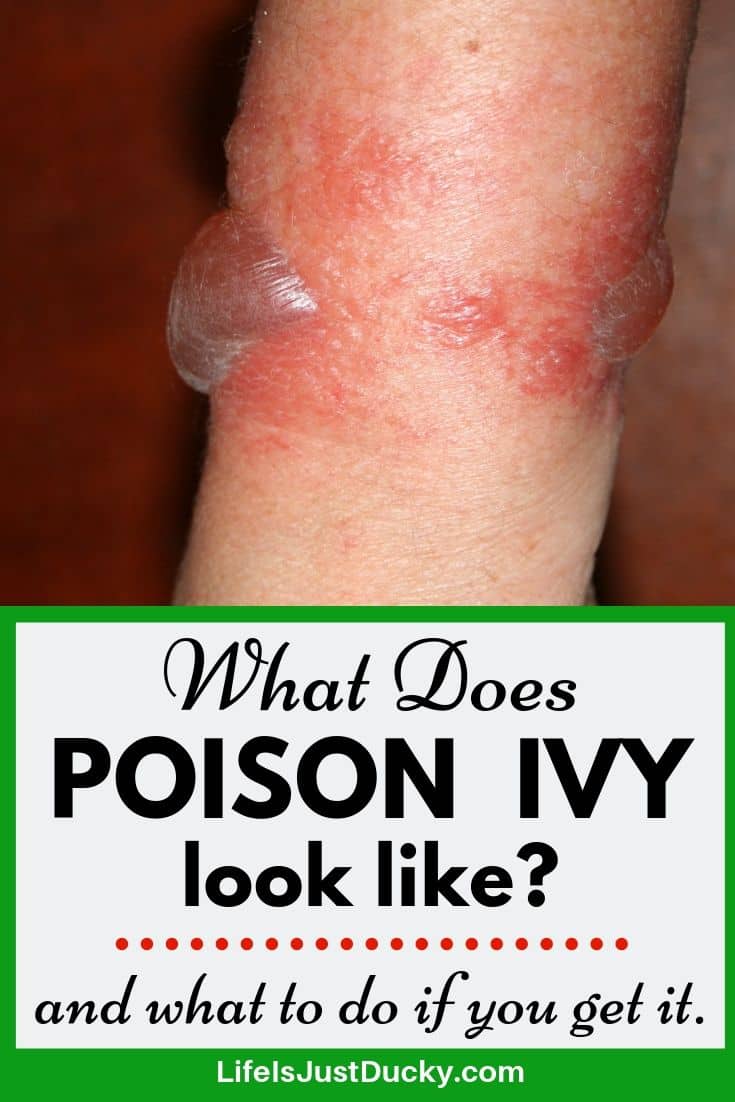
Home Remedies For Poison Ivy
But for most of us that have a mild to moderate reaction, you may just want herbs and over-the-counter medications to relieve the allergic symptoms and help it heal quicker.
Once you have washed all the urushiol oil off your skin…
Jewelweed
Jewelweed is reported to be the most effective herb for reducing symptoms. When you need relief from the itching, jewelweed is a gem. Simply split the stem of the jewelweed and apply the juice to affected areas. As luck would have it, jewelweed often grows near the ivy.
If you don’t find it wild, you can grow your own in an herb garden. An herb garden is a wonderful thing to have, or use this jewelweed salve, For ready-made relief,
How to use fresh jewelweed to treat poison ivy.
-
Chop jewelweed leaves, stems, and flowers. Put them in a pot.
-
Cover with water and simmer until reduced by half.
-
Use in a compress.
-
Or freeze the liquid in ice cube trays. Use the cubes directly on the skin.
Plantain
Plantain (the herb not the banana-like plant) is also an excellent herb used the same way and even in conjunction with Jewelweed.
You can also use the simmered plantain juice in a soothing bath (after all urushiol is removed from your skin)
Or blend plantain with equal parts water, making it into a “smoothie” and dab on affected areas.
If you don’t have it growing in your area, you can buy the herb dried.
Raw Apple Cider Vinegar and Bentonite Clay
Combining them into a paste will help heal up the rash and small blisters.
Baking Soda
Make a paste with a little water. It works similar to bentonite clay and most of us have it in our kitchens.
Aloe Vera
The gel from aloe vera can be very effective for relieving a poison ivy rash. If you have access to an aloe vera leaf, you can apply the gel directly to the skin. However, if you don’t have this, you can purchase an aloe vera product from your local store or online.
Epsom Salt
Add two cups of Epsom Salt to warm bath water and then soak in the tub for about 20 minutes.
Turmeric
A paste made with turmeric and lemon juice helps rash blister dry out and hastens the healing process. Apply the paste directly to the area for about 15 minutes and then gently wipe off. (Don’t worry about the yellow stain the skin turmeric causes, because it will fade soon.)
Oatmeal
Oatmeal baths have been around forever for all things itchy. Blend 1 cup to a powder, put in a cheesecloth or bandana, put under the faucet of warm running water.
You can also make a paste of the oatmeal powder to dab on.
Related: 19 Best Ways To Get Rid Of Mosquitoes.
Conclusion – How To Identify And Treat Poison Ivy
I hope you never have to suffer through the rash and blisters of poison ivy, like I did. But if you do, know there is relief where you might not expect it.
Next post is about how to get rid of the poison ivy plant from your yard or property.
If this post has been helpful to you, Please Share It.
Happy Gardening!
 I believe everyone can grow at least part of their own food! Let me show you how.
I believe everyone can grow at least part of their own food! Let me show you how.



I’ve been running the affected areas (my arms) under very hot water for 20 seconds. Applied calamine lotion after drying. Stops the itch for a few hours.
Thank you for sharing. It is miserable stuff.
I am very sensitive to poison ivy and have found that washing with Fels Naptha (yellow soap) does a great job in keeping poison ivy from spreading. I leave a soap film on the affected area and let it dry. It also helps with the itching.
Good to know. It’s so important to find things that work.